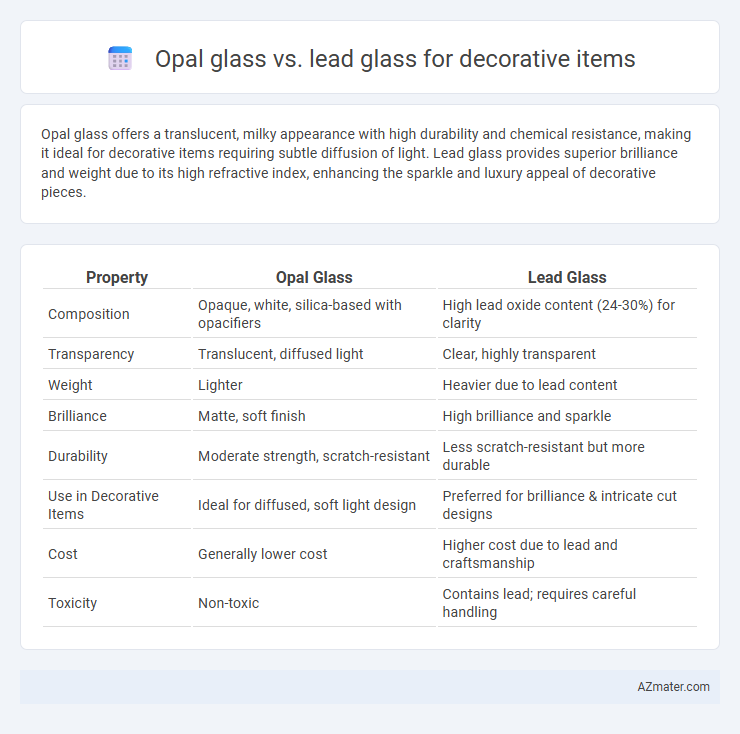Opal glass offers a translucent, milky appearance with high durability and chemical resistance, making it ideal for decorative items requiring subtle diffusion of light. Lead glass provides superior brilliance and weight due to its high refractive index, enhancing the sparkle and luxury appeal of decorative pieces.
Table of Comparison
| Property | Opal Glass | Lead Glass |
|---|---|---|
| Composition | Opaque, white, silica-based with opacifiers | High lead oxide content (24-30%) for clarity |
| Transparency | Translucent, diffused light | Clear, highly transparent |
| Weight | Lighter | Heavier due to lead content |
| Brilliance | Matte, soft finish | High brilliance and sparkle |
| Durability | Moderate strength, scratch-resistant | Less scratch-resistant but more durable |
| Use in Decorative Items | Ideal for diffused, soft light design | Preferred for brilliance & intricate cut designs |
| Cost | Generally lower cost | Higher cost due to lead and craftsmanship |
| Toxicity | Non-toxic | Contains lead; requires careful handling |
Introduction to Decorative Glass: Opal vs Lead
Opal glass features a milky, translucent appearance achieved by adding bone ash or fluorides during production, offering a soft, diffused light effect ideal for decorative items. Lead glass, containing a high percentage of lead oxide, provides superior clarity, brilliance, and a heavier feel, making it a preferred choice for luxury decorative pieces and fine craftsmanship. Both types serve decorative purposes but differ significantly in optical properties, weight, and safety considerations due to lead content.
Composition Differences: Opal Glass and Lead Glass
Opal glass is primarily composed of silica, soda, lime, and small amounts of opacifiers such as bone ash or tin oxide, giving it a milky, translucent appearance ideal for decorative items. Lead glass contains a significant proportion of lead oxide, typically ranging from 18% to 40%, which increases its refractive index and density, resulting in enhanced brilliance and weight. The composition differences affect durability, optical properties, and suitability for various decorative techniques, with lead glass offering superior clarity and light dispersion compared to the softer, frosted look of opal glass.
Aesthetic Qualities: Appearance and Color
Opal glass offers a soft, milky white appearance with a smooth, matte finish that diffuses light gently, enhancing the subtle elegance of decorative items. Lead glass features high clarity and brilliant transparency, producing a sparkling effect with vibrant light refraction that highlights intricate details and enhances color richness. The choice between opal and lead glass depends on the desired aesthetic, with opal glass providing a muted, sophisticated look and lead glass delivering a dazzling, luminous quality.
Light Diffusion and Optical Effects
Opal glass offers superior light diffusion with its milky, translucent appearance, creating a soft, even glow ideal for decorative items that require gentle illumination. Lead glass, enriched with lead oxide, provides enhanced brilliance and clarity, producing sharper optical effects and pronounced light refraction for sparkling highlights. The choice between opal glass and lead glass depends on whether the emphasis is on diffused ambient light or striking, clear visual impact in decorative applications.
Weight and Handling Considerations
Opal glass is lighter than lead glass, making it easier to handle and less prone to breakage during transportation or display. Lead glass, due to its higher density from lead oxide content, offers a heavier, more substantial feel but requires careful handling to prevent damage. The weight difference significantly affects user experience, with opal glass favored for delicate decorative items needing frequent movement.
Durability and Strength Comparison
Opal glass offers moderate durability with a smooth, matte finish ideal for decorative items requiring a soft look, while lead glass is significantly stronger due to its lead oxide content, providing superior durability and resistance to impact. Lead glass also has a higher density and brilliance, making it more suitable for intricate, high-quality decorative pieces that demand both strength and aesthetic appeal. Opal glass may chip or crack more easily under stress compared to the resilient, heavy-duty nature of lead glass.
Safety and Toxicity Concerns
Opal glass, composed primarily of silica and some opacifiers like bone ash or tin oxide, offers a safer alternative to lead glass due to its non-toxic composition, eliminating lead exposure risks in decorative items. Lead glass contains significant amounts of lead oxide, which improves clarity and weight but poses toxicity concerns, especially if it leaches lead through prolonged contact or damage. For decorative items, opal glass is preferred in environments prioritizing health safety, whereas lead glass requires careful handling and regulation to prevent lead poisoning.
Price and Market Availability
Opal glass typically offers a more affordable price point compared to lead glass, making it a popular choice for decorative items on a budget. Lead glass, known for its brilliance and weight, commands higher prices due to its higher lead oxide content and premium craftsmanship. Market availability favors opal glass for mass-produced decorative pieces, while lead glass remains sought after in luxury and artisanal segments with limited but steady demand.
Popular Uses in Decorative Items
Opal glass is widely favored for decorative items such as lampshades, vases, and bathroom fixtures due to its smooth, translucent appearance that diffuses light softly. Lead glass, known for its high refractive index and brilliance, is commonly used in fine crystalware, chandeliers, and ornamental bowls that demand clarity and sparkle. Both materials enhance decorative aesthetics, with opal glass providing a matte, elegant glow and lead glass offering dazzling brilliance ideal for luxury decor.
Choosing the Right Glass for Your Project
Opal glass offers a smooth, milky translucence ideal for diffused light in decorative items, enhancing softness and elegance. Lead glass provides higher clarity and brilliance with added weight, making it perfect for intricate designs requiring sparkle and durability. Selecting the right glass depends on the desired aesthetic effect, light diffusion, and project requirements for visual appeal and functionality.

Infographic: Opal glass vs Lead glass for Decorative item
 azmater.com
azmater.com